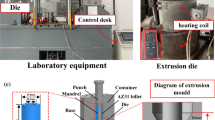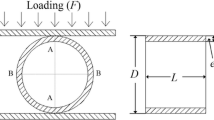Abstract
Flow-formability of a Ca-added AZ31 magnesium alloy tube is investigated. The flow-forming process is conducted at various temperatures (100–500 °C), thickness reductions (30–85%), and feed rates (0.1–0.56 mm/rev). Inner and outer surfaces of the tubes are heated by means of a thermal element embedded inside the mandrel and a radiation element, respectively. The formed tubes are visually inspected for the occurrence of cracking and fractures. Microstructures and tensile properties of the samples are analyzed by optical microscopy and tensile test, respectively. It is shown that deformation above 200 °C is required for sound processing with the occurrence of dynamic recrystallization (DRX). Up to 200 °C, the twinning-induced shear banding is the dominant phenomenon in microstructural evolution and responsible for the early strain localization and subsequent fracture. By increasing the temperature, the maximum achievable thickness reduction increases. However, at about 300 °C, the maximum thickness reduction reaches a limit value of about 76%. A twist in the deformed part of the tube occurs at greater thickness reductions. A simple analytical model is presented to analyze the occurrence of the twist phenomenon. Accordingly, a flow-formability map is proposed for the alloy. The DRX grain size is shown to follow a power law with the temperature compensated strain rate known as the Zener–Hollomon parameter. While the grain size is not affected by the feed rate, dimensional accuracy is deteriorated at feed rates over 0.2 mm/rev due to the diametral growth of the workpiece. Based on the tensile test results, by increasing the deformation temperature, the tensile strength increases and the ductility decreases, so that the sample processed at 500 °C shows a brittle fracture. The impacts of temperature on the strength and ductility are attributed to the combined effects of microstructural and texture evolutions during the flow-forming process.












Similar content being viewed by others
References
Mordike BL, and Ebert T, Mater Sci Eng A 302 (2001) 37. https://doi.org/10.1016/S0921-5093(00)01351-4.
Fata A, Mater Sci Eng A 674 (2016) 9. https://doi.org/10.1016/j.msea.2016.07.117.
Nie X W, Xie S, Xu H, and Du Y, Physica B Condens Matter 405 (2010) 1969. https://doi.org/10.1016/j.physb.2010.01.075.
Yamashita A, Horita Z, and Langdon T G, Mater Sci Eng A 300 (2001) 142. https://doi.org/10.1016/S0921-5093(00)01660-9.
Wang Q, Chen Y, Liu M, Lin J, and Roven H J, Mater Sci Eng A 527 (2010) 2265. https://doi.org/10.1016/j.msea.2009.11.065.
Chandrasekaran M, and John Y M S, Mater Sci Eng A 381 (2004) 308. https://doi.org/10.1016/j.msea.2004.04.057.
Yang H, Huang L, and Zhan M, Comput Mater Sci 47 (2010) 857. https://doi.org/10.1016/j.commatsci.2009.11.014.
Huang C H, Hung C H, Hung J C, and Lin C R, Int J Adv Manuf Technol 56 (2011) 1039. https://doi.org/10.1007/s00170-011-3247-0.
Ghandehari F M R, Mazinani M, and Ebrahimi G R, Mater Sci Eng A 606 (2014) 214. https://doi.org/10.1016/j.msea.2014.03.104.
Bohlen J, Yi S B, Swiostek J, Letzig D, Brokmeier H G, and Kainer K U, Scripta Materialia 53 (2005) 259. https://doi.org/10.1016/j.scriptamat.2005.03.036.
Cao Z, Wang F, Wan Q, Zhang Z, Jin L, and Dong J, Mater Des 67 (2015) 64. https://doi.org/10.1016/j.matdes.2014.11.016.
Parsa M H, Pazooki A M A, and Ahmadabadi N M, Int J Adv Manuf Technol 42 (2009) 463. https://doi.org/10.1007/s00170-008-1624-0.
Wong C C, Dean T A, and Lin J, J Mater Process Technol 153-154 (2004) 60. https://doi.org/10.1016/j.jmatprotec.2004.04.102.
Mohebbi M S, and Akbarzadeh A, J Mater Process Technol, 210 (2010) 389. https://doi.org/10.1016/j.jmatprotec.2009.09.028.
Haghshenas M, Jhaver M, Klassen R J, and Wood J T, Mater Des 32 (2011) 3629. https://doi.org/10.1016/j.matdes.2011.02.014.
Zhang Y, Wang F, Dong J, Jin L, Liu C, and Ding W J, Mater Sci Technol 34 (2018) 1091. https://doi.org/10.1016/j.jmst.2017.12.007.
Fong K S, Wong C C, Atsushi D, Key Eng Mater, Trans Tech Publ 447 (2010) 427. https://doi.org/10.4028/www.scientific.net/KEM.447-448.427
Kwak T Y, Lim H K, and Kim W J, J Alloys Comp 658 (2016) 157. https://doi.org/10.1016/j.jallcom.2015.10.193
Mohebbi M S, and Rahimi Pour M, Int J Adv Manuf Technol 103 (2019) 377. https://doi.org/10.1007/s00170-019-03528-1.
Roy M J, Klassen R J, and Wood, J T J Mater Process Technol 209 (2009) 1018. https://doi.org/10.1016/j.jmatprotec.2008.03.030.
Rajan K M, and Narasimhan K Pract Fail Anal 1 (2001) 69. https://doi.org/10.1007/bf02715366
Zecevic M, Beyerlein I J, and Knezevic M, J Mech Phys Solids 111 (2018) 290. https://doi.org/10.1016/j.jmps.2017.11.004.
Al-Samman T, and Gottstein G, Mater Sci Eng A, 490 (2008) 411. https://doi.org/10.1016/j.msea.2008.02.004.
Doege E, and Kurz G, CIRP Ann 50 (2001) 177. https://doi.org/10.1016/S0007-8506(07)62099-X.
Xu Y, Zhang S H, Li P, Yang K, Shan D B, and Lu Y, J Mater Process Technol 113 (2001) 710. https://doi.org/10.1016/S0924-0136(01)00644-6.
Kalpakcioglu S, J Eng Ind 86 (1964) 49.
Hosford W F, and Caddell R M, Metal Forming: Mechanics and Metallurgy Cambridge University Press (2011).
Zhan M, Yang H, Zhang J H, Xu Y L, and Ma F, J Mater Process Technol, 187 (2007) 486. https://doi.org/10.1016/j.jmatprotec.2006.11.114.
Ma Z, J Mater Process Technol 37 (1993) 217. https://doi.org/10.1016/0924-0136(93)90092-K.
Atik K, and Efe M, Mater Sci Eng A 725 (2018) 267. https://doi.org/10.1016/j.msea.2018.03.121.
Klimanek P, and Pötzsch A, Mater Sci Eng A 324 (2002) 145. https://doi.org/10.1016/S0921-5093(01)01297-7.
Humphreys F J, and Hatherly M, Recrystallization and Related Annealing Phenomena, Elsevier (2012).
Li L L, Cai Z Y, Xu H Q, Wang M, and Yu J, Int J Adv Manuf Technol 75 (2014) 897. https://doi.org/10.1007/s00170-014-6186-8.
Murata M, Kuboki T, and Murai T, J Mater Process Technol 162 (2005) 540.
Fata A, Faraji G, Mashhadi M M, and Tavakkoli V, Arch Metall Mater 62 (2017) 159. https://doi.org/10.1515/amm-2017-0022.
Chaudry U M, Kim T H, Kim Y S, Hamad K, Ko Y G, and Kim J G, Mater Sci Eng A 762 (2019) 138085. https://doi.org/10.1016/j.msea.2019.138085.
Mohebbi M, and Akbarzadeh A, Mater Sci Eng A 528 (2010) 180. https://doi.org/10.1016/j.msea.2010.08.081.
Chang C I, Lee C J, and Huang J C, Scripta Materialia 51 (2004) 509. https://doi.org/10.1016/j.scriptamat.2004.05.043.
Ammouri A, Kridli G, Ayoub G, and Hamade R F, J Mater Process Technol 222 (2015) 301. https://doi.org/10.1016/j.jmatprotec.2015.02.037.
Maksoud I A, Ahmed H, and Rödel J, Mater Sci Eng A 504 (2009) 40. https://doi.org/10.1016/j.msea.2008.10.033.
Tavakkoli V, Afrasiab M, Faraji G, and Mashhadi M M, Mater Sci Eng A 625 (2015) 50. https://doi.org/10.1016/j.msea.2014.11.085.
Barnett M R, Nave M D, and Bettles C J, Mater Sci Eng A 386 (2004) 205. https://doi.org/10.1016/j.msea.2004.07.030.
Nave M D, and Barnett M R, Scripta Materialia 51 (2004) 881. https://doi.org/10.1016/j.scriptamat.2004.07.002.
Ma Q, El Kadiri H, Oppedal A L, Baird J C, Li B, Horstemeyer M F, and Vogel S C, Int J Plast 29 (2012) 60. https://doi.org/10.1016/j.ijplas.2011.08.001.
Brown D W, Agnew S R, Abeln S P, Blumenthal W R, Bourke M A, Mataya M C, Tomé C, and Vogel S C, Mater Sci Eng A 399 (2005) 1. https://doi.org/10.1016/j.msea.2005.02.016.
Author information
Authors and Affiliations
Corresponding authors
Additional information
Publisher's Note
Springer Nature remains neutral with regard to jurisdictional claims in published maps and institutional affiliations.
Rights and permissions
About this article
Cite this article
Fata, A., Tavakkoli, V. & Mohebbi, M.S. Investigation of Flow-Formability of an AZ31 Magnesium Alloy. Trans Indian Inst Met 73, 2601–2612 (2020). https://doi.org/10.1007/s12666-020-02047-y
Received:
Accepted:
Published:
Issue Date:
DOI: https://doi.org/10.1007/s12666-020-02047-y




